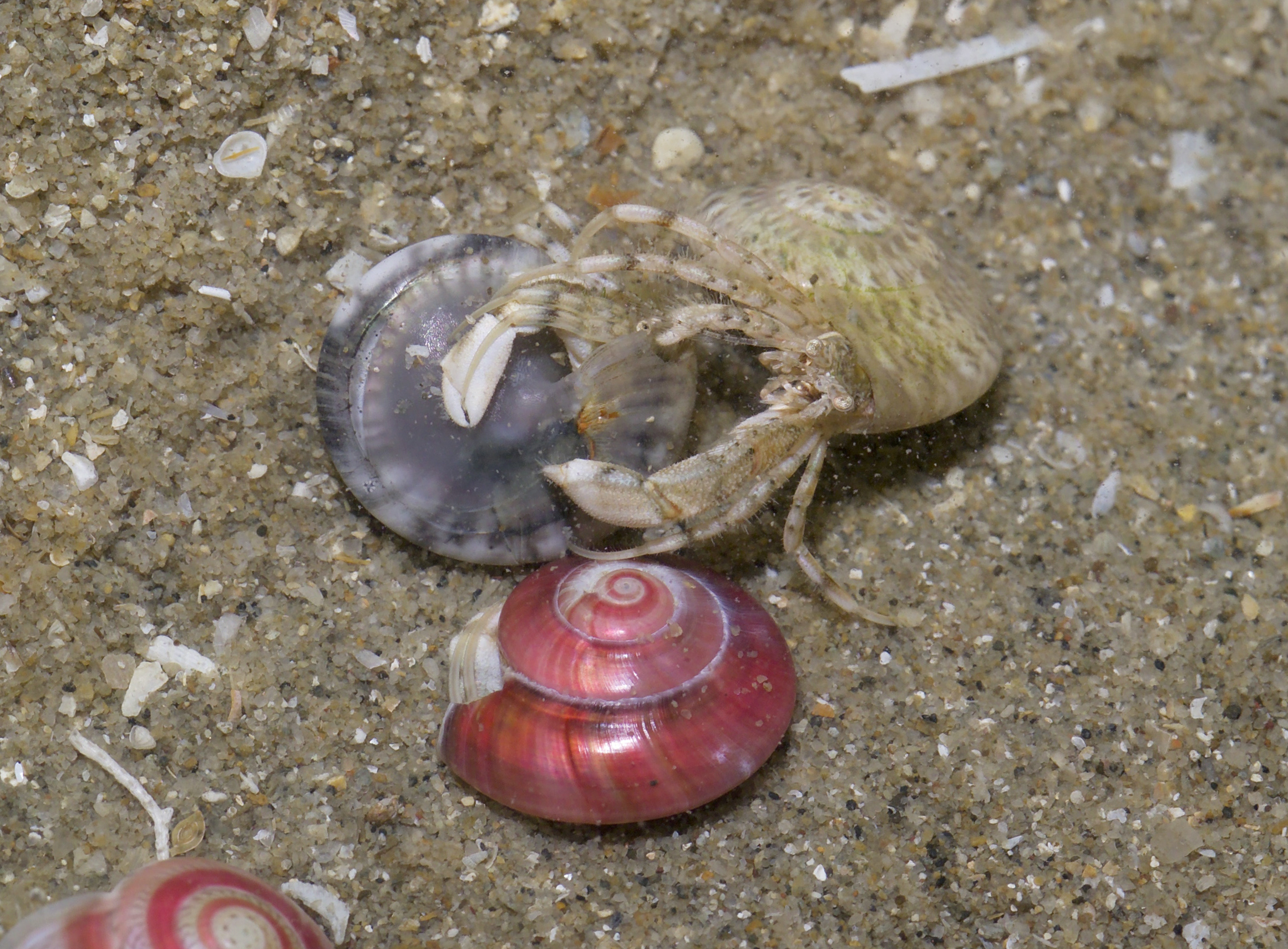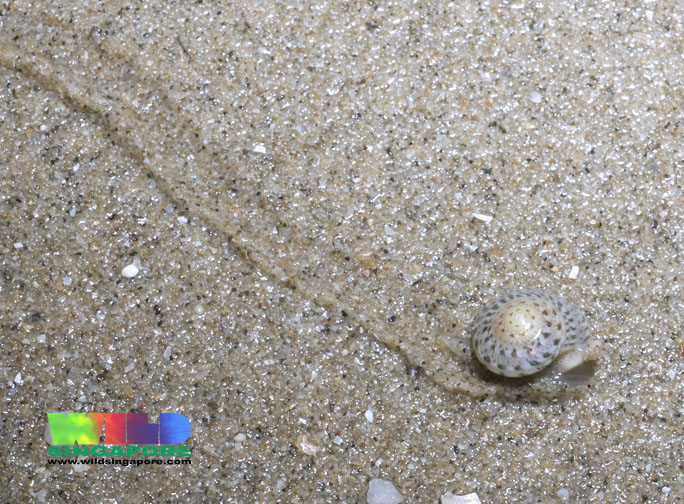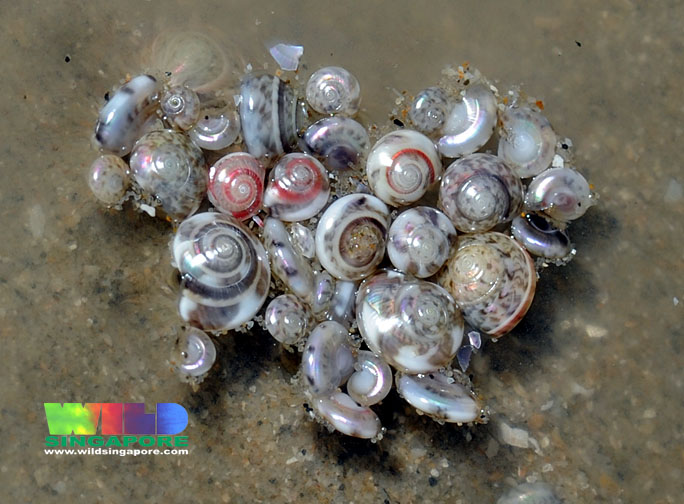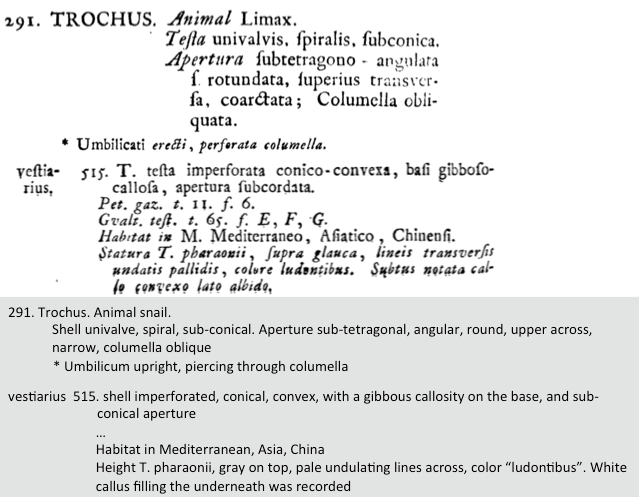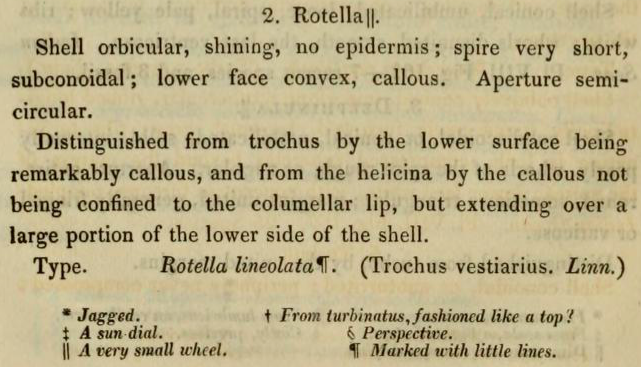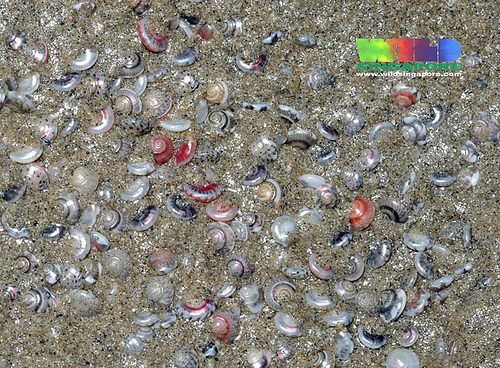 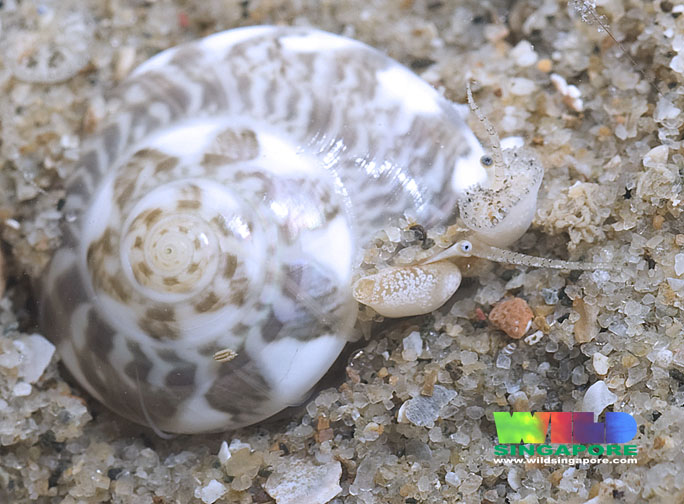 |
| Figure 1: Button snails found on sandy beach (left) and a close-up of the snail (right). Photo: © 2008 & 2012 Ria Tan (CC BY-NC-ND 2.0) |
Table of Contents
1. Physical appearance
Button snail has round and glossy shell with various patterns and colours (Figure 2). Its average shell width is 1 cm, with maximum of 1.5 cm[1]. More information about its identifying features can be found on 5(ii) Diagnostic features.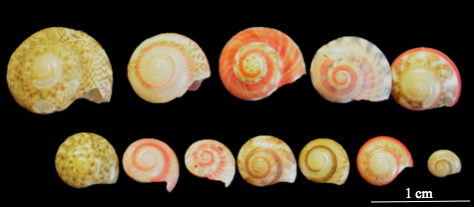 |
| Figure 2: Various shell patterns of button snail. Photo: © 2015 Jenny |
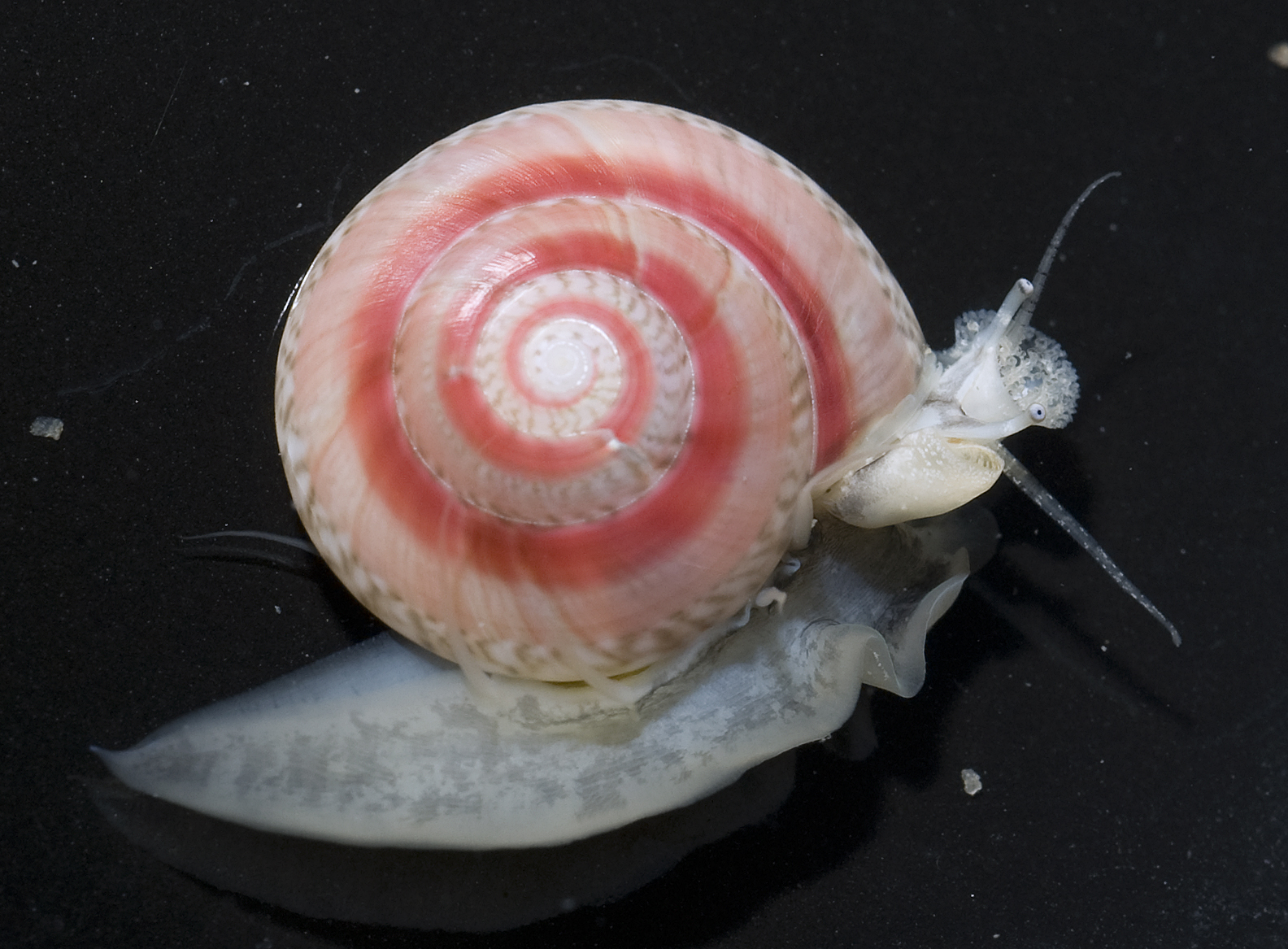 |
|
| Figure 3: Button snail. Photo © 2012 Ria Tan (CC BY-NC-ND 2.0) |
Figure 4: Hermit crab living in an empty button snail. Photo: © 2005 Ria Tan (CC BY-NC-ND 2.0) |
2. Distribution
(i) Habitat
Button snail inhabits surface layers of marine sands in shallow water and also low-shore mud flats. It prefers sand of medium grade and avoids finer sand grains or muddy sand[6,7]. It has greatest abundance on undisturbed beaches with medium wave energy[3].(ii) Worldwide
It is commonly found in Indo-Pacific: East Africa, India, Southeast Asia, and Australia (Figure 5)[1].(iii) Singapore
It is abundant in the sandy shores in Singapore (Figure 5; e.g. Changi, Chek Jawa, Cyrene Reef, East Coast Park, and Tanah Merah)[8]. Empty shells are often washed ashore on mid and high level tide.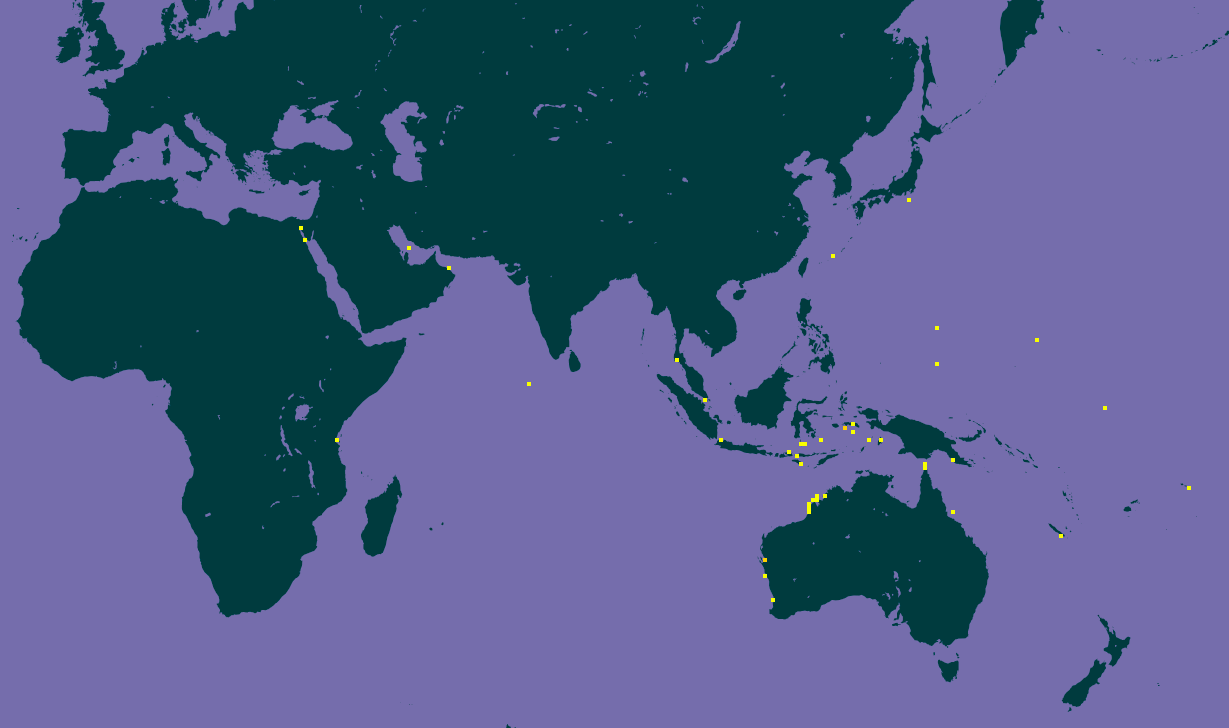 |
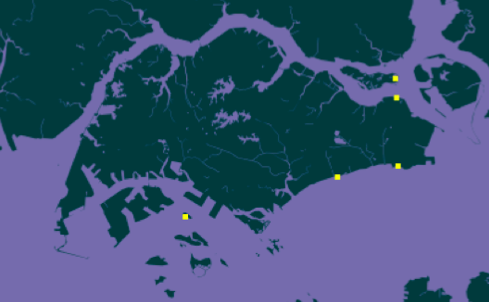 |
| Figure 5: Global distribution of button snail. Source: Global Biodiversity Information Facility (CC BY 3.0)[9] |
Figure 6: Distribution of button snail in Singapore. Base map from Global Biodiversity Information Facility (CC BY 3.0)[9] ; reference points adapted from Lee Kong Chian Natural History Museum[8] |
3. Biology
(i) Behaviour
As the tide recedes, button snail buries itself and closes the aperture of its shell with operculum before the surface of the sand dries; it resumes its activity when the tide rises[10]. As it creeps, a path marking is made by the edge of the outer lip of the shell and the foot[10], forming a trail (Figure 7 and 8). Owing to its low spire and smooth surface, button snail encounters little resistance to burrow[10]. The front end of the foot, which is split into two parts, is curved, allowing it to carry out ploughshare-like action[10,11] (Figure 7). The modification of the foot facilitates its movement in soft substrata, but traversing across hard substratum is difficult[10]. This may explain why button snail is found on sandy shores, and not rocky ones. To escape predators, button snail may perform a series of rolling movements by twisting their foot side to side[12]. High density of button snail, up to 77,700 snails per m2[10], may be found in one spot (Figure 9). By actively fixing mucus from its expanded foot with sediment, button snail can aggregate and gain greater resistance from being washed away in high energy shores, where optimal feeding and reproduction can be achieved[10].| Figure 7: Labels of selected anatomy. Photo: © 2012 Ria Tan (CC BY-NC-ND 2.0), labelled and edited by Jenny. Insert photo: © 2015 Jenny |
| Figure 8: Path marking made as button snail creeps on sand. Photo: © 2011 Ria Tan (CC BY-NC-ND 2.0) |
Figure 9: Aggregation of floating button snail. Photo: © 2008 Ria Tan (CC BY-NC-ND 2.0) |
|
(ii) Feeding
Button snail is a suspension feeder. It belongs to genus Umbonium, the only filter-feeding gastropod group with inhalant and exhalant siphons[10]. It picks up food as it glides over the sand surface or if it is buried, it will extend its two siphons to filter feed instead, as shown in Figure 10[10].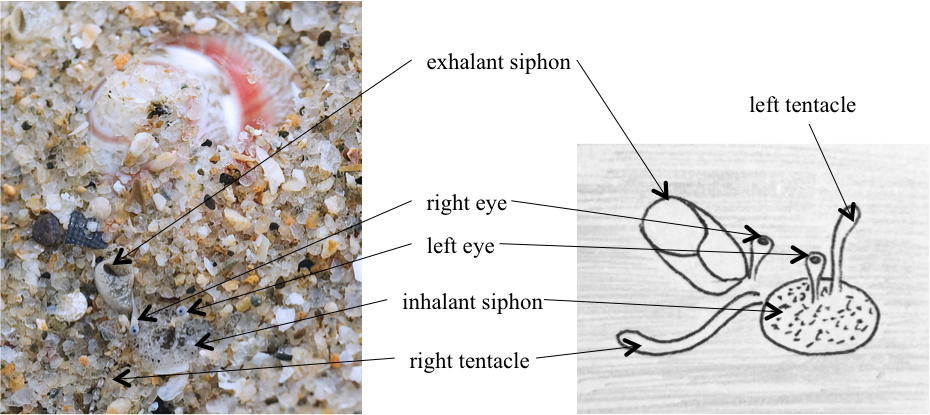 |
| Figure 10: Button snail buried in sand in feeding position. Left photo: © 2012 Ria Tan (CC BY-NC-ND 2.0), labelled by Jenny. Right illustration by Jenny, with reference to [13] |
(iii) Predators
Button snail is preyed mainly by moon snails (Naticidae) and starfish (Astropectinidae), and occasionally by a few other marine invertebrates and fish (Figure 11)[14,15].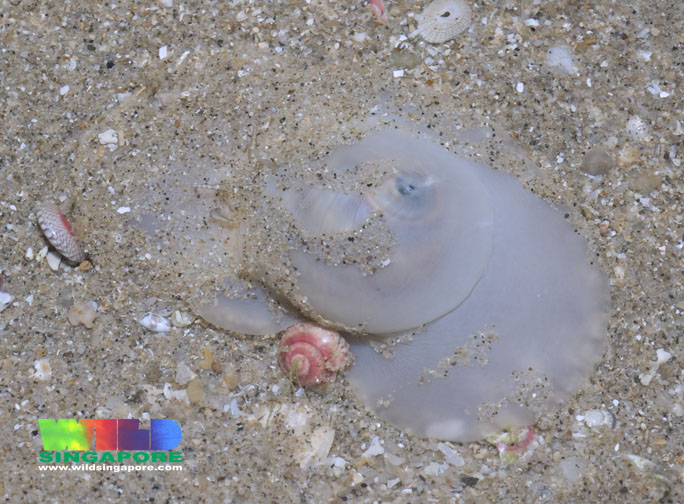 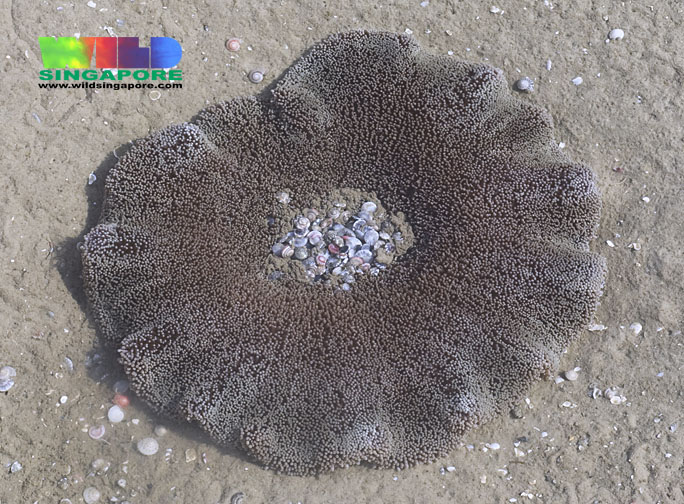 |
| Figure 11: Button snails being preyed by moon snail (left) and Haddon's carpet anemone (right). Photo: © 2011 & 2005 Ria Tan (CC BY-NC-ND 2.0) |
(iv) Reproduction & Lifespan
Button snail has separate sexes (i.e. dioious). Similar to other trochacaeans in the family, button snail is a broadcast spawner and carries out external fertilization because it lacks the accessory reproductive organs for internal fertilisation[15]. Most favourable condition for spawning occurs during the period of weakest neap tides with high water level during mid-day because there is minimum change in water level, providing permanent cover[15,16]. Based on a study done for a population in Peninsular Malaysia, the greatest amount of spawning was recorded between March and August[17]. Mid-day spawning is advantageous because it allows the trochophore and early veligers larvae, which are negatively gravitaxis and will orient themselves against gravity and move upwards, to have light-enhanced upward swimming. This promotes faster growth before the night sets, before the development of positively gravitaxis veligers[15]. As a result of weak dispersal, the offspring is likely to settle on the same shore. However, weak dispersal is favourable to button snail. Given that the juvenile live and grow for one year before breeding and then die the following mid-year[10,15], there will be little competition between established parents and settling juveniles[15]. To compensate for its short life, button snail also has high reproduction output[17]. |
| Figure 12: Different stages of development of button snail. Illustration by Jenny, with reference to [18] |
4. Anthropogenic threats
Global threatsIn the early 20th century, it was said that millions of button snails were exported from India to Europe for shell craft industry: their button-like shape and wide variety of colour patterns make them very attractive[19].Therefore, over-collection may be a possible threat to button snails. They are often used as accessories in aquarium and home decorations (Figure 13). Human consumption is another threat: vendors may use aromatic thorns (Acacia pennata) to pry the meat out from the shell[1]. In addition, increased turbidity from beach sand mining may interfere with the suspension feeding of the snail and the settlement of its juvenile[3]. Marine pollution may also render sand to be non-habitable by button snails as they avoid acid-treated sand[20].
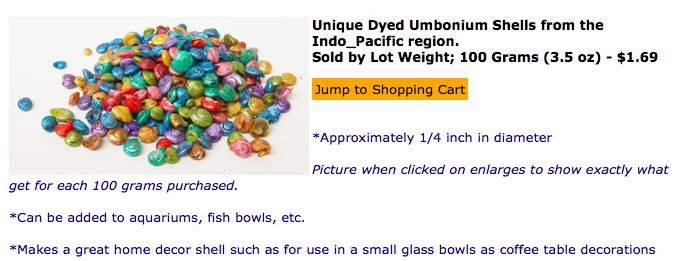 |
| Figure 13: Screenshot of button snail for sale on http://www.americanaquariumproducts.com/UmboniumShells.html |
Local threats in Singapore
Button snail used to be highly abundant in the 1960s, but due to habitat loss and degradation, its populations have declined drastically[21]. It is now listed as ‘vulnerable’ on Singapore Red Data Book 2008[22].
5. Taxonomy and systematics
(i) Nomenclature
Scientific name: Umbonium vestiarium (Linnaeus, 1758)Common names: Button snail, Button top
Taxonavigation:
| Kingdom |
Animalia |
| Phylum |
Mollusca |
| Class |
Gastropoda |
| Subclass |
Vetigastropoda |
| Order |
Archaeogastropoda |
| Family |
Trochidae |
| Genus |
Umbonium |
| Species |
U. vestiarium |
| Trochus vestiarius Linnaeus, 1758 |
| Globulus vestiarius Schumacher, 1817 |
| Rotella lineolata Lamarck, 1822 |
(ii) Diagnostic features
Shell round, flat, lenticular, much wider the long[1]. Spire low and spire whorls without concentric grooves; periphery of whorls uniformly rounded[1]. Umbilical surface flattened and thickened by calcareous deposits that fill the umbilicus[1]. Shell glossy with various patterns and colours; umbilical callus generally of different colour from the shell[1]. Operculum circular, relatively thick, and completely close the aperture[31]. Radula rhipidoglossan, not so developed, reduced in tooth cusps as it is a filter-feeder[10,31]. Ctenidium monopectinate, and attached to mantle throughout its length[10,31]. |
| Figure 14: Selected identifying features of Umbonium vestiarium. Photo: © 2015 Jenny, with reference to [1] |
(iii) Taxonomic history
Umbonium vestiarium was originally described by Linnaeus in 1758 using the name Trochus vestiarius and he noted that the umbilicus was filled with callus (Figure 15)[23]. The genus Globulus, assigned by Schumacher in 1817, is an objective synonym of genus Umbonium, meaning that both Globulus and Umbonium contain the same species (i.e. U. vestiarium), but Umbonium (Link, 1807) has precedence because it is older. Later on, Lamarck thought that the snail had "remarkably callous" lower surface compared to other Trochus, so he gave a new name, Rotella lineolata, in 1822 (Figure 16)[24]. He also took the liberty to change the species name from vestiarius to lineolata, something that he has often done for other genera as well, creating confusion[25]. Subsequently, Dr Arthur Adams placed the snail under genus Umbonium in 1851 (Figure 17)[26].(iv)Type information
No valid holotype was found for Umbonium vestiarium. This is because the specimen (Trochus vestiarius) that was assigned as the type actually referred to Umbonium callous; nevertheless, that specimen is a valid holotype for genus Umbonium as it was the first species described for the genus[27,28]. This specimen is kept in Uppsala University Zoological Museum[28]. No record of syntypes and lectotypes of U. vestiarium could be found. Its type locality, as appointed by Linnaeus in his original description, is Mediterrranean, Asia, and China[23].(v) Phylogeny
Traditionally, phylogeny of family Trochidae was constructed based on morphology such as radula and ctenidium. For instance, subfamily Umboniinae, Lirulariinae, and Halistylinae were grouped together owing to them having monopectinate ctenidium and reduced radula[32]. However, recent molecular study has revealed that Lirularia is nested within Umboniinae[29]. Using concatenated sequences from 28S rRNA, 12S rRNA, 16S rRNA, and CO1, this study also shows that subfamily Umboniinae—represented by closely related species of Umbonium vestiarium, namely Umbonium giganteum, Umbonium costatum, and Umbonium monileferum—is a monophyletic group[29]. No phylogenetic record of U. vestiarium, allowing it to be placed on phylogenetic trees, could be found; more research is needed to shed light on the phylogeny of U. vestiarium.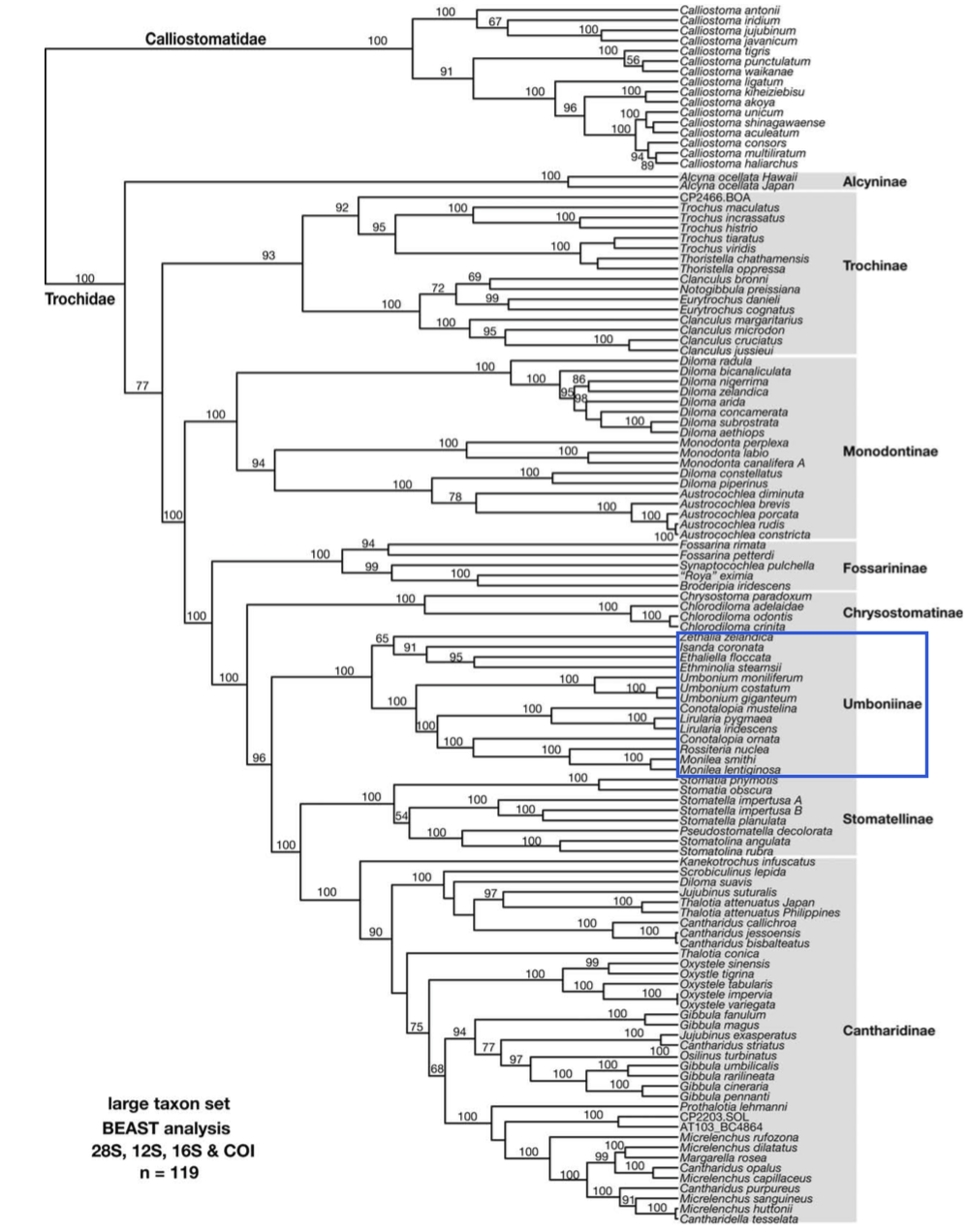 |
| Figure 18: Molecular phylogeny of Trochidae and Calliostomatidae, with subfamily Umboniinae highlighted in blue, based on concatenated sequences from four genes using Bayesian analysis with uncorrelated relaxed, lognormal clock using BEAST. Source: Williams et al., 2010[29] (Permission granted) |
6. External resources
- WoRMS (World Register of Marine Species)
- WildSingapore
- EOL (Encyclopedia of Life)
- SeaLife
- GenBank records
7. References
[1] Carpenter, K. E., & V. H. Niem, 1998. FAO species identification guide for fishery purposes. The living marine resources of the Western Central Pacific. Volume 1. Seaweeds, corals, bivalves and gastropods. Food and Agriculture Organization of The United Nations, Rome. 686 pp.[2] Leimar, O., 2005. The evolution of phenotypic polymorphism: randomized strategies versus evolutionary branching. The American Naturalist, 165(6): 669-681.
[3] Sivadas, S., B. Ingole, & A. Sen, 2012. Some ecological aspects and potential threats to an intertidal gastropod, Umbonium vestiarium. Journal of Environmental Biology, 33: 1039-1044.
[4] Allen, J.A. & B. C. Clarke, 1984. Frequency-dependent selection – Homage to Poulton, E.B”. Biological Journal of the Linnean Society, 23:15-18.
[5] Miura, O., S. Nishi, & S. Chiba, 2007. Temperature-related diversity of shell colour in the intertidal gastropod Batillaria. Journal of Molluscan Studies, 73(3): 235-240.
[6] Tamaki, A., & T. Kikuchi, 1983. Spatial arrangement of macrobenthic assemblages on an intertidal sand flat, Tomioka Bay, west Kyushu. Publications from Amakusa Marine Biology Laboratory, Kyushu University, 7: 41-60.
[7] Kalyanasundaram, N., S. S. Ganti, & A. A. Karande, 1972. The habitat and the habitat-selection by Umbonium vestiarium L. Proceedings of Indian National Science Academy, 38: 275-287.
[8]"Umbonium vestiarium (Linnaeus, 1758)". Lee Kong Chian Natural History Museum, n.d. URL: http://lkcnhm.nus.edu.sg/dna/organisms/details/847 (accessed on 7 November 2015)
[9] "Umbonium vestiarium Linnaeus 1758". GBIF Secretariat: GBIF Backbone Taxonomy, 2013. URL: http://www.gbif.org/species/4358247 (accessed on 11 November 2015)
[10] Fretter, V., 1975. Umbonium vestiarium, a filter‐feeding trochid. Journal of Zoology, 177(4): 541-552.
[11] Adams, A., 1860. On the animal of Umbonium vestiarium. Annals and Magazine of Natural History, 6(3): 288-289
[12] Ansell, A. D., 1969. Escape responses of 3 Indian mollusks. Veliger, 12(2): 157-159.
[13] Heller, J., 2015. Sea Snails: A natural history. Springer, Switzerland. 354 pp.
[14] Berry, A. J., 1984. Umbonium vestiarium (L.)(Gastropoda, Trochacea) as the food source for naticid gastropods and a starfish on a Malaysian sandy shore. Journal of Molluscan Studies, 50(1): 1-7.
[15] Berry, A. J., 1986. Daily, tidal, and two-weekly spawning periodicity and brief pelagic dispersal in the tropical intertidal gastropod Umbonium vestiarium (L.). Journal of experimental marine biology and ecology, 95(3): 211-223.
[16] Ryland, J. S., & P. A. Tyler (eds.), 1989. Reproduction, Genetics and Distributions of Marine Organisms: 23rd European Marine Biology Symposium, School of Biological Sciences, University of Wales, Swansea. Olsen & Olsen, Denmark. 469 pp.
[17] Berry, A. J., 1987. Reproductive cycles, egg production and recruitment in the Indo-Pacific intertidal gastropod Umbonium vestiarium (L.). Estuarine, Coastal and Shelf Science, 24(5): 711-723.
[18] Hickman, C. S., 1992. Reproduction and development of trochacean gastropods. Veliger, 35(4): 245-272.
[19] Hornell, J., 1951. Indian molluscs. Bombay Natural History Society, India. 96 pp
[20] Kalyanasundaram, N., S. S. Ganti, & A. A. Karande, 1972. The habitat and the habitat-selection by Umbonium vestiarium L. Proceedings of Indian National Science Academy, 38: 275-287.
[21] "Umbonium vestiarium (Linnaeus, 1758)". Flora & Fauna Web, n.d. URL: https://florafaunaweb.nparks.gov.sg/Special-Pages/animal-detail.aspx?id=187 (accessed on 9 Nov 2015)
[22] Davison, G.W.H., P. K. L. Ng, & H. C. Ho (eds.), 2008. The Singapore Red Data Book (2nd Edition). Nature Society (Singapore), Singapore. 285 pp.
[23] Linnaeus, C.,1758. Systema Naturae per regna tria naturae, secundum classes, ordines, genera, species, cum characteribus, differentiis, synonymis, locis. Editio decima, reformata. Laurentius Salvius, Holmiae. 824 pp.
[24] Children, J. G., 1823. Lamarck's genera of shells. Quarterly Journal of Science, Literature and the Arts, 15: 216-258.
[25] de Lamarck, J. B. D. M. & C. Dubois, 1825. An epitome of Lamarck's arrangement of Testacea: being a free translation of that part of his works, De l'histoire des animaux sans vertebras. Longman, Hurst, Rees, Orme, Browne, and Green, London. 317 pp.
[26] Hermannsen, K., 1851. On some genera of shells, established in 1807 by the late H. F. Link. Proceedings of the Zoological Society of London (Part 19). 228-233
[27] Tyron, G. W. & H. A. Pillsbury, 1889. Manual of conchology, structural and systematic: with illustrations of the species (Vol 11). Academy of Natural Sciences, Philadelphia. 519 pp.
[28] "Catalogue of type specimens. 4. Linnaean specimens". Uppsala University Museum of Evolution Zoology section, 2001. URL: http://www.evolutionsmuseet.uu.se/samling/UUZM04_Linnaeus.pdf (accessed 11 Nov 2015)
[29] Williams, S. T., Donald, K. M., Spencer, H. G., & T. Nakano, 2010. Molecular systematics of the marine gastropod families Trochidae and Calliostomatidae (Mollusca: Superfamily Trochoidea). Molecular Phylogenetics and Evolution, 54(3): 783-809.
[30] Chan, Z. W. I., 2013. Quantifying shell pattern and colour polymorphism in Umbonium vestiarium (L.) (Gastropoda, Trochacea). Unpublished student report, National University of Singapore, Singapore. 17 pp.
[31] Herbert, D. G. (1992). Revision of the Umboniinae (Mollusca: Prosobranchia: Trochidae) in Southern Africa and Mozambique. Annals of the Natal Museum, 33(2): 379-459
[32] Hickman, C. S., & McLean, J. H. (1990). Systematic revision and suprageneric classification of trochacean gastropods. Natural History Museum Los Angeles County Science Series, 35: 1-169.
